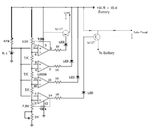samshoppy
Newbie level 3
I have modified basic lm339 comparator circuit to work as shunt mode solar charger.
Pin 1 works as low voltage cutout. When voltage drops, led goes off and tip127 turns off.
Pin 14 works as overcharge cutout. Normally led remains on & tip127 also. Current flows to battery through tip127. when voltage goes high led goes off and tip 127 stops charging. Diodes at Emitter protects direct flow of current in both sides. 100k is used for hysteresis.
Please add auto switch on circuit when current from solar panel stops flowing.

Pin 1 works as low voltage cutout. When voltage drops, led goes off and tip127 turns off.
Pin 14 works as overcharge cutout. Normally led remains on & tip127 also. Current flows to battery through tip127. when voltage goes high led goes off and tip 127 stops charging. Diodes at Emitter protects direct flow of current in both sides. 100k is used for hysteresis.
Please add auto switch on circuit when current from solar panel stops flowing.
